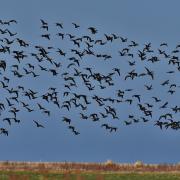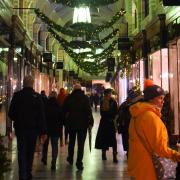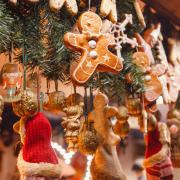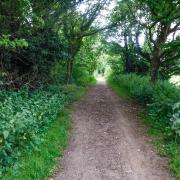Almost half of the world's population of grey seals lives around the British coast. And Norfolk is an important breeding area for these charismatic creatures. Grey seal breeding season is from November to January and the pups, with their big soulful eyes and fluffy white coats, are an increasingly popular draw for visitors. Seeing the awesome spectacle of hundreds of seals on the beach has become a real winter tradition for many, especially at Christmas and new year.
There are regular boat trips from Morston Quay to see the seals at Blakeney Point, which is home to England's largest grey seal colony - around 4,000 seal pups are born each year - and it was featured in an episode of Sir David Attenborough's TV series Wild Isles. Head further east and the flat beaches, shallow waters and high dunes around Horsey and Winterton are another ideal location for the females to give birth.

The charity Friends of Horsey Seals ensures that it's a safe experience for the seals and wildlife watchers. It came into being in 2012 when funding for a Natural England and Broads Authority project to protect the seals which had started to give birth on Horsey beach came to an end. The trained wardens make sure that the seals are kept safe and create a positive experience for visitors. They also have a seal rescue team. Trained by the RSPCA, it operates seven days a week to rescue injured and distressed seals.
You can also go seal spotting in the summer. Between June and August common seals and their pups populate Blakeney Point and the sandbanks of Hunstanton. You can distinguish common seals by their short noses (grey seals have long, flat noses) and their pups are born with brown fur. They are also smaller - they are up to 1.6m in length and up to 100kg in weight, whereas grey seals can be 2.5 metres in length and males can weigh as much as 300kg.

Grey seals are thought to be able to dive to depths of 300m and stay underwater for up to 20 minutes.
Grey seal milk contains up to 50-60 % fat -10 times more than a Jersey cow’s milk - which helps the pups gain weight rapidly and develop a layer of blubber. Pups go from their birthweight of around 13kg to 45 kg in just three weeks.
Grey seals and other pinnipeds (seals, sea lions and walruses) use highly sensitive whiskers known as mystacial vibrissae to detect fish-generated water movements when hunting in murky water with poor visibility or dark conditions.
Pups are born with a white coat known as a 'lanugo'. They moult this after they are weaned, around three weeks after they are born. The process of growing a shorter adult waterproof coat takes another three weeks or so.

Grey seals typically return to breed and moult to one particular location and female grey seals often return to have their pups at the colony where they were born.
Female grey seals only suckle pups for 17 to 23 days and then their job is done. The pups stay behind on the beach alone for around another three weeks to moult their white coats and grow a grey waterproof one. They fast during this time, living off their fat.
When they are ready the pups go into the sea and teach themselves to fish.
Male seals are called bulls, female seals are cows and baby seals pups.
Bulls live for up to 25 years and cows live for around 35 years.
Seals can sleep on or even underwater. They can float vertically in the sea, with just their heads poking out of the water to breathe, which is known as bottling. Others can slow their heartbeat down to conserve oxygen and roll around on the seabed enjoying 40 winks for up to two hours.
You might spot a seal in an unexpected location. Last year a grey seal was spotted outside a kebab shop in Hemsby after taking a wrong turn from the dunes.
Source: Friends of Horsey Seals

If you're planning a trip to see the seals at Horsey and Winterton, here is all you need to know.
Stay off the beach
During the 12-week breeding season, from November to February, keep to the paths and roped-off viewing areas and stay off the beach. This is to ensure that both visitors and seals are kept safe and avoid unnecessary erosion on the dunes. Seal wardens will be able to direct you to the best viewing points.
Keep your distance
Don't let their cuteness fool you - seals are feisty and territorial animals. Keep a minimum of 10 metres away from them and never get too close or walk between a cow and pup - they are likely to desert their pups if you disturb them, leaving them to starve.
Keep your dog on a short lead
Females are very protective of their pups and will bite if a dog gets too close. If your dog is bitten, it will need to see a vet immediately as seal bites can cause nasty infections. Another reason that dogs should not be let off the lead is that seals sometimes go up into the dunes as well as onto the beach, so you may happen upon one unexpectedly.
Don't disturb lone seals
It is common to spot pups which appear to be on their own. In the three weeks after they're born their mothers might leave them for a short while to swim and hunt for food. The cows leave their pups after about 21 days, then in the following three weeks the pups will stay on the beach on their own while they moult their white fur, living off their fat reserves. Unless a seal appears injured or distressed, it should be left alone. Do not try to help a seal yourself - advise a warden.
Take your rubbish home with you
It goes without saying that you should never leave litter behind - it is hazardous to the local wildlife. And not just during pupping season. Fishing lines, ropes, nets and plastic flying rings can cause nasty injuries to seals.
Visit friendsofhorseyseals.co.uk




























